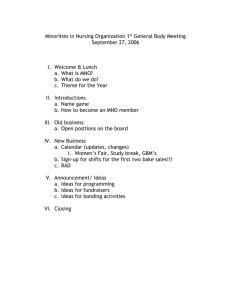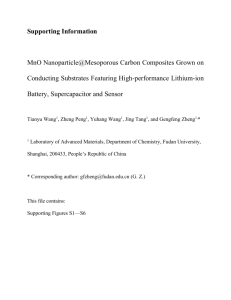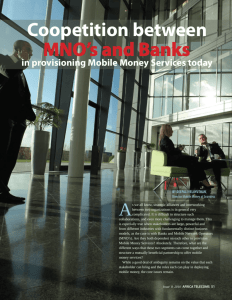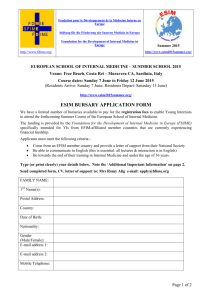Standardization of Embedded UICC Remote Provisioning
advertisement
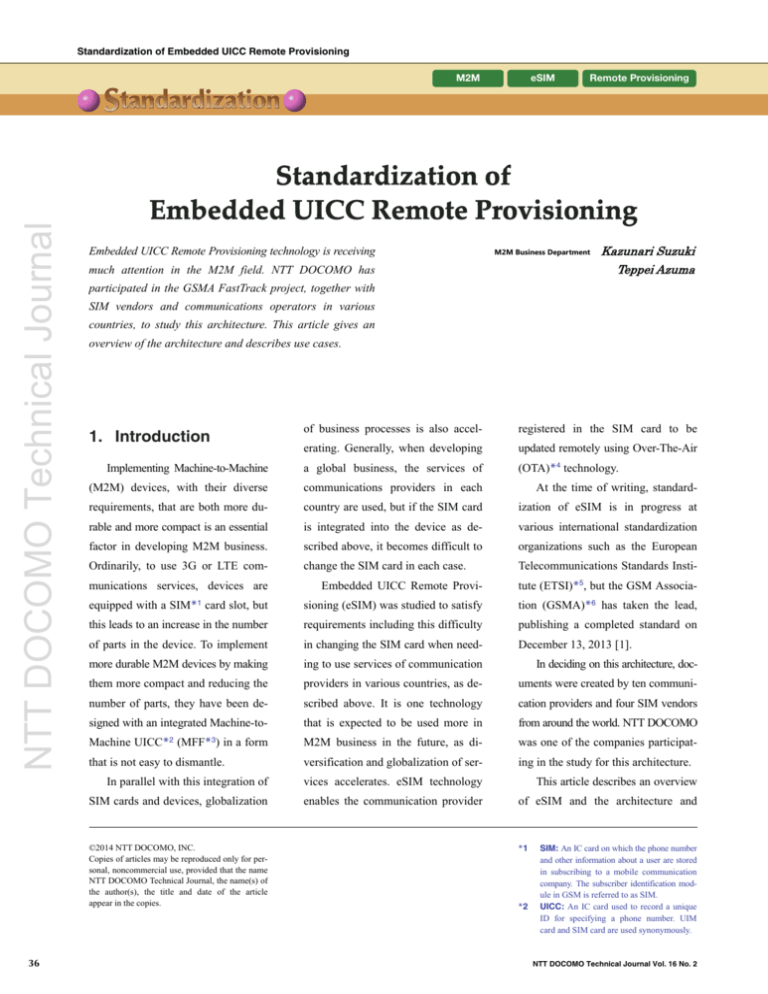
Standardization of Embedded UICC Remote Provisioning NTT DOCOMO Technical Journal M2M Embedded UICC Remote Provisioning technology is receiving Remote Provisioning M2M Business Department much attention in the M2M field. NTT DOCOMO has Kazunari Suzuki Teppei Azuma participated in the GSMA FastTrack project, together with SIM vendors and communications operators in various countries, to study this architecture. This article gives an overview of the architecture and describes use cases. of business processes is also accel- registered in the SIM card to be erating. Generally, when developing updated remotely using Over-The-Air Implementing Machine-to-Machine a global business, the services of (OTA)*4 technology. (M2M) devices, with their diverse communications providers in each At the time of writing, standard- requirements, that are both more du- country are used, but if the SIM card ization of eSIM is in progress at rable and more compact is an essential is integrated into the device as de- various international standardization factor in developing M2M business. scribed above, it becomes difficult to organizations such as the European Ordinarily, to use 3G or LTE com- change the SIM card in each case. Telecommunications Standards Insti- 1. Introduction munications services, devices are Embedded UICC Remote Provi- tute (ETSI)*5, but the GSM Associa- equipped with a SIM*1 card slot, but sioning (eSIM) was studied to satisfy tion (GSMA)*6 has taken the lead, this leads to an increase in the number requirements including this difficulty publishing a completed standard on of parts in the device. To implement in changing the SIM card when need- December 13, 2013 [1]. more durable M2M devices by making ing to use services of communication In deciding on this architecture, doc- them more compact and reducing the providers in various countries, as de- uments were created by ten communi- number of parts, they have been de- scribed above. It is one technology cation providers and four SIM vendors signed with an integrated Machine-to- that is expected to be used more in from around the world. NTT DOCOMO M2M business in the future, as di- was one of the companies participat- versification and globalization of ser- ing in the study for this architecture. Machine UICC*2 (MFF*3) in a form that is not easy to dismantle. In parallel with this integration of vices accelerates. eSIM technology This article describes an overview SIM cards and devices, globalization enables the communication provider of eSIM and the architecture and ©2014 NTT DOCOMO, INC. Copies of articles may be reproduced only for personal, noncommercial use, provided that the name NTT DOCOMO Technical Journal, the name(s) of the author(s), the title and date of the article appear in the copies. 36 eSIM *1 *2 SIM: An IC card on which the phone number and other information about a user are stored in subscribing to a mobile communication company. The subscriber identification module in GSM is referred to as SIM. UICC: An IC card used to record a unique ID for specifying a phone number. UIM card and SIM card are used synonymously. NTT DOCOMO Technical Journal Vol. 16 No. 2 describes some use cases. 2. eSIM Overview NTT DOCOMO Technical Journal 2.1 Current SIM Cards device) (Figure 2). With conven- ID, which is used as the unique key tional SIM cards, the ICCID is used for the eSIM (Table 1). as the unique key to identify the SIM GSMA defines two main types of card, but with eUICC, the ICCID is profile. Communication using current SIM the key used to identify profiles, and 1) Provisioning Profile cards is showed in Figure 1. The a new ID is defined, called the eUICC- communications profile*7 This is the communication profile of a single Mobile Network Operator (MNO) is M2M device stored in the SIM card, and it is used SIM card Other party MNO A NW MNO A Communication profile for communication. The communica- Enterprise server Communication using MNO A’s network Internet ICCID:ABC tions profile includes the information needed by each MNO for communi- Stores values for using MNO A cation, including the Mobile Subscriber ISDN number (MSISDN)*8 and the International Mobile Subscriber Identity (IMSI)*9. The MNO is fixed Title Value MSISDN 8190AAAABBBB IMSI 44010ABC…XYZ Other information used for communication in each SIM card and cannot be changed. Figure 1 For this reason, the SIM card in Communication using current SIM cards the device must be changed each time a different MNO is used. M2M device eSIM eUICC‐ID:ABC 2.2 eUICC A eUICC is a SIM card with a Remote Provisioning function, and is MNO A Communication profile enable MNO B Communication profile disable designed not to be removed or changed. MNO A communication profile MNO B communication profile It is able to store multiple commu- Title Value Title Value ICCID 8981100AB…YZ ICCID 891BCD…WXY nication profiles, one of which is MSISDN 8190AAAABBBB MSISDN 1BBB…CCC enabled (recognized by the device IMSI 44010ABC…XYZ IMSI 310BCD…WXY and used for communication). The Other information used for communication Other information used for communication network of the MNO in the enabled To the M2M device, this is recognized as a SIM card for MNO A, which is enabled. The MNO B profile is disabled, and not recognized by the M2M device. profile is used for communication. Profiles other than the enabled profile Figure 2 are disabled (not recognized by the *3 *4 *5 MFF: An acronym for M2M Form Factor. Refers to a UICC for M2M applications. OTA: Technology for writing data or updating using wireless communications. ETSI: A European standardization body engaged in the standardization of telecommunications technologies. Headquartered in Sophia Antipolis, France. NTT DOCOMO Technical Journal Vol. 16 No. 2 *6 GSMA: An association that supports and manages activities of the mobile industry such as formulating roaming rules. World’s largest industry association in the mobile communications domain. About 800 mobile operators 219 regions and more than 200 IPX operators, terminal, equipment and software vendors have joined the Association. eUICC overview *7 *8 *9 Profile: A set of files containing the information needed for communication (IMSI, MSISDN, etc.). MSISDN: The phone number assigned to each subscriber as specified by the 3GPP. IMSI: A number used in mobile communications that is unique to each user and stored on a UIM card. 37 Standardization of Embedded UICC Remote Provisioning initially stored in the eUICC when it or the Internet. It can also perform tion, but rather switches profiles based is shipped. It is a limited-application the roles provided by a Provisioning on instructions from equipment called communication profile used only for profile. a Subscription Manager. A Subscrip- NTT DOCOMO Technical Journal downloading and switching Opera- 3. eSIM Architecture Overview tional Profiles, described next. 2) Operational Profile aged by an MNO. The overall eSIM architecture, centering on the Subscrip- This is a communication profile An eSIM does not perform profile tion Manager, is shown in Figure 3, for connecting to enterprise servers switching as a simple IC card func- using the example of switching pro- Table 1 Comparison of eUICC and SIM cards eUICC SIM card Card unique key eUICC-ID * Has ICCIDs as unique keys for profiles ICCID Number of profiles Multiple 1 Number of enabled profiles 1 1 MNO User Managed on Subscription Manager Subscription Manager 2. Instruction to switch to MNO B. 3. Instruction to switch to MNO B. Profile download MNO B Communication profile eSIM Data management Profile management Switch‐completed notification MNO A NW MNO B NW 5. Communication using the MNO B network. 1. Communication using the MNO A network. M2M device M2M device M2M device eSIM eUICC‐ID:ABC eSIM eUICC‐ID:ABC eSIM eUICC‐ID:ABC MNO A Communication profile MNO A Communication profile enable MNO A Communication profile disable MNO B Communication profile disable MNO B Communication profile enable enable Figure 3 38 tion Manager is maintained and man- 4. Profile switch Profile switching using the Subscription Manager NTT DOCOMO Technical Journal Vol. 16 No. 2 pleting the process. The same pro- ates a communication profile. It then An eUICC must have at least one cedure is used to switch back to the stores the profile it has created. profile stored in it to enable OTA original MNO A, or to some other 2) Role of SM-SR functionality, and one of the stored MNO C. NTT DOCOMO Technical Journal files within the eUICC. The SM-SR has the role of estab- profiles must be enabled. The enabled As mentioned earlier, profile switch- lishing secure communication with the profile uses the network of MNO A ing is implemented using Subscription eUICC. The communication profiles for communication. When the user Manager functionality. The Subscrip- stored in an eUICC are highly con- switches profiles, a switch instruction tion Manager has two roles: Sub- fidential information and require a is sent to the Subscription Manager. scription Manager Data Preparation mechanism to prevent them from being At that time, if the profile to switch (SM-DP), and Subscription Manager read or altered easily from outside to is not stored in the eUICC, the Secure Routing (SM-SR). Here we the system. For this reason, a secure profile is first downloaded. When it describe these Subscription Manager environment is built by separating the receives a switch instruction, the functions in detail using Figure 4. SM-DP, which creates the profiles, eUICC performs a switch of the en- 1) Role of SM-DP and the SM-SR, which establishes abled profile as an internal process. The SM-DP securely creates and communication with the eUICC. The After the switch is completed, it uses stores communication profiles. It re- SM-SR has an eUICC Information the network of MNO B to send noti- ceives the information it needs to cre- Set (EIS) for establishing secure com- fication that the switch has completed ate a communication profile (MSISDN, munication with the eUICC. The EIS to the Subscription Manager, com- IMSI, etc.) from the MNO, and cre- has key information for accessing the Create/store communication profiles Subscription Manager SM‐DP Profile management SM‐SR MNO A Communication profile MNO B Communication profile eSIM Data management eSIMData management eUICC‐ID : EIS for ABC eSIM eUICC‐ID:ABC MNO A Communication profile enable MNO B Communication profile disable eUICC‐ID : EIS for DEF (1) SM–SR establishes secure communication with eUICC. (2) SM–SR, executes switch instruction. (3) As needed, install profiles stored in SM–DP. Figure 4 NTT DOCOMO Technical Journal Vol. 16 No. 2 Subscription Manager functional details 39 NTT DOCOMO Technical Journal Standardization of Embedded UICC Remote Provisioning eUICC (the Platform Management conventional SIM cards, cards with a ferent region, so it was difficult to Credential) and state information such different communication profile for use services continuously. In contrast, as whether each profile is enabled or each country being shipped to have with the introduction of eSIMs, it is disabled. to be built into the device, produc- possible to switch profiles using OTA The Platform Management Cre- tion and distribution lines for each technology, so services can be used dential enables the SM-SR to access had to be established and managed, more seamlessly than with conven- the eUICC securely and to perform and production and delivery quantities tional SIM cards in global use cases. instructions to switch the enabled had to be adjusted for each region. This should lower the barriers to de- profile. With the introduction of eSIMs, it is veloping global businesses (Figure 6). possible to switch profiles using a 4. Use Cases process desired by the user. This enables implementation of optimized In this article we have given an eSIM below. logistics, such as changing the region overview of eSIM with use cases, 1) Optimizing Logistics to which products are shipped based based on documents published by the Often in the M2M field, it is on the actual balance of supply and GSMA. Standardization activities are difficult to remove the SIM from a demand, even after production and expected to continue at international device, or the device is installed in a shipping (Figure 5). standardizations such as the ETSI, remote location difficult to reach for 2) Provision of Continuous Service using the GSMA documents as input. We introduce two use cases for maintenance. For example, global pro- When M2M devices are used glob- In parallel with technical standard- duction and delivery of products is a ally, with conventional SIM cards ization, GSMA is also creating au- case having these conditions. With they had to be changed for each dif- thorized standards for operational as- Conventional logistics Logistics after introducing eSIM. Production and distribution lines for each developed region. Profiles can be switched, so production and distribution lines can be merged. Figure 5 40 5. Conclusion Use case (logistics optimization) NTT DOCOMO Technical Journal Vol. 16 No. 2 NTT DOCOMO Technical Journal Conventional service provision Change SIM card Profile switch Change SIM card Difficult to provide continuous service Continuity is poor for services requiring SIM cards to be changed Figure 6 Service provision after introducing eSIM Continuous service can be provided Seamless OTA switching is possible, so service continuity is high Use case (providing continuous service) pects such as the Subscription Man- developing M2M businesses in the ager. Internet Of Things (IOT) era. NTT DOCOMO will continue with standardization activities and technical study in the future, to contribute to NTT DOCOMO Technical Journal Vol. 16 No. 2 Profile switch REFERENCES [1] GSM Association: ‟Embedded SIM Remote Provisioning Architecture.” http://www.gsma.com/connectedliv ing/wp-content/uploads/2014/01/1.GSMA-Embedded-SIM-RemoteProvisioning-Architecture-Version1.1.pdf 41
